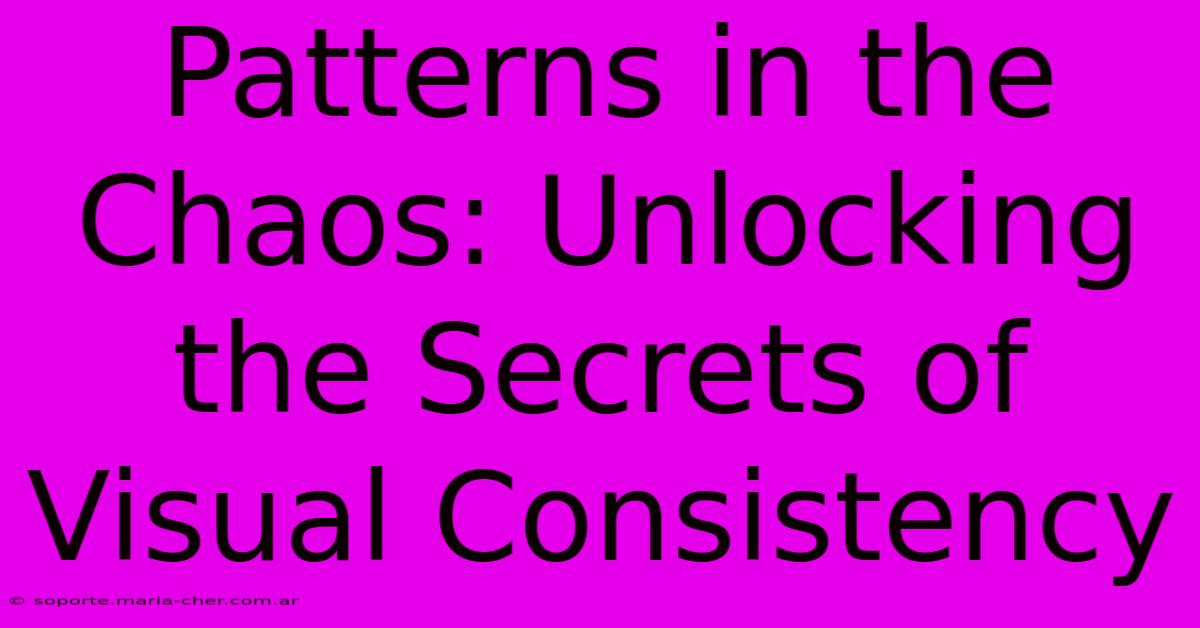Patterns In The Chaos: Unlocking The Secrets Of Visual Consistency

Table of Contents
Patterns in the Chaos: Unlocking the Secrets of Visual Consistency
Visual consistency. It’s a term thrown around a lot in design, but what does it really mean? And more importantly, why is it so crucial for the success of any brand, website, or piece of marketing material? This article delves into the power of visual consistency, exploring its underlying principles and showing you how to unlock its secrets to create a truly memorable and impactful brand identity.
What is Visual Consistency, Anyway?
Visual consistency, in its simplest form, is the practice of maintaining a uniform style across all your visual communication. This isn't just about using the same logo everywhere; it's about creating a cohesive experience for your audience, regardless of where they encounter your brand. This involves carefully considering elements like:
-
Color Palette: Sticking to a limited, carefully chosen range of colors ensures a unified feel. Think of the instantly recognizable green of Starbucks or the vibrant red of Coca-Cola. These colors are integral to their brand identity.
-
Typography: Using consistent fonts (or a limited selection of complementary fonts) maintains readability and reinforces your brand personality. A playful script font might suit a bakery, while a bold sans-serif font might be ideal for a tech company.
-
Imagery and Style: The style of your photography, illustrations, and other visuals should align with your overall brand aesthetic. Are you going for a sleek and modern look or a rustic and handcrafted feel? Consistency in your imagery is key.
-
Layout and Grid Systems: Even the underlying structure of your designs plays a role. Using consistent layouts and grid systems helps create visual harmony and improves user experience.
-
Logo and Branding Elements: This is the most obvious aspect of visual consistency. Your logo, brand colors, and other key elements should be used consistently across all platforms.
Why is Visual Consistency So Important?
The benefits of visual consistency extend far beyond aesthetics. A visually consistent brand creates a stronger, more memorable impression on your audience. Here’s why:
-
Brand Recognition: Consistent visual elements help people instantly recognize your brand, even from a distance or a quick glance. This is crucial for building brand awareness and recall.
-
Trust and Credibility: A polished, consistent visual identity projects professionalism and builds trust with your audience. Inconsistency, on the other hand, can make your brand appear unprofessional or unreliable.
-
Improved User Experience: A visually consistent website or app is easier to navigate and understand, leading to a more positive user experience. Users feel more comfortable and confident when they can easily find what they're looking for.
-
Enhanced Marketing Effectiveness: Consistent branding across all marketing materials ensures a cohesive message, leading to more effective campaigns.
Building Visual Consistency: A Step-by-Step Guide
Creating a visually consistent brand isn't magic; it's a strategic process. Follow these steps:
-
Define Your Brand Identity: Before you start designing anything, clearly define your brand's personality, values, and target audience. This will inform all your visual choices.
-
Develop a Style Guide: Create a comprehensive style guide that outlines all your brand's visual elements, including your logo, color palette, typography, and imagery style. This guide will serve as a reference for all your design work.
-
Apply Consistency Across All Platforms: Ensure your brand's visual identity is consistent across your website, social media, marketing materials, and any other touchpoints.
-
Regularly Review and Update: Your brand may evolve over time, so it’s important to regularly review and update your style guide to reflect these changes.
The Power of Pattern in Visual Design
Visual consistency relies heavily on establishing patterns. Repeating certain elements – colors, fonts, layouts – creates a sense of order and familiarity. This predictability is what makes a brand recognizable and trustworthy. Breaking patterns should be done sparingly and intentionally, to emphasize a specific element or create a surprise. Too much variation can lead to visual chaos and confusion.
Conclusion: Embrace the Pattern, Master the Chaos
Visual consistency isn't just about aesthetics; it's a powerful tool for building a strong and memorable brand. By understanding its principles and implementing them strategically, you can create a cohesive and impactful brand identity that resonates with your audience and drives business success. Remember, embracing the power of pattern will help you unlock the secrets of visual consistency and bring order to the creative chaos.

Thank you for visiting our website wich cover about Patterns In The Chaos: Unlocking The Secrets Of Visual Consistency. We hope the information provided has been useful to you. Feel free to contact us if you have any questions or need further assistance. See you next time and dont miss to bookmark.
Featured Posts
-
Rose Quartz Reverie Delving Into The Tranquility Of Pink Roses
Feb 08, 2025
-
Indulge In The Opulence Of Ecuadorian Roses Without Ruining Your Budget
Feb 08, 2025
-
Through The Lens Of A Master Helmut Newtons Provocative And Glamorous Eye
Feb 08, 2025
-
Unveil The Secrets Unveiling The Graceful Allure Of St John Evening Gowns
Feb 08, 2025
-
Instant Gratification At Your Fingertips Exploring The Exact Dimensions Of Polaroid Images
Feb 08, 2025
